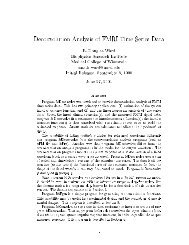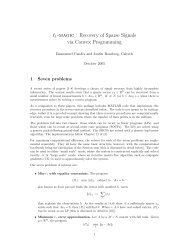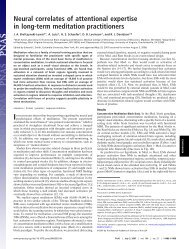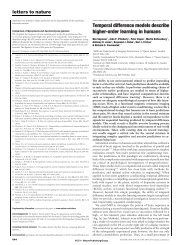Table 3Discrimination Between Which of the Two Positive Films WasRated as Most Happy or Most Amusing on the Basisof D-<strong>Smile</strong>s <strong>and</strong> O-<strong>Smile</strong>s% of hits Chi-square pHappiness ratings<strong>Duchenne</strong> smiles 73 25.25 .0001Other smiles 41 ! .027 nsAmusement ratings<strong>Duchenne</strong> smiles 65 15.45 .0001Other smiles 44 1.899 nsDUCHENNE SMILE 349cantly less right-hemisphere compared with left-hemisphere alphapower (p < .0 l).<strong>The</strong> overall ANOVA on the anterior temporal EEG revealed aCondition (D-smile-O-smile-baseline) × Hemisphere interactionthat fell just short of significance, F(2, 24) = 3.23, p < .06,with Huynh-Feldt correction. As we observed for the otherbrain regions, no significant main effects were obtained. <strong>The</strong>Condition x Hemisphere interaction for the direct comparisonof the D-smile <strong>and</strong> O-smile periods also fell short of significance,F(l, 12) = 3.79, p < .08. Because this interaction waspredicted by Hypothesis 4a, we computed the simple effects. AsFigure 5 indicates, D-smiles were associated with significantlymore left anterior activation (i.e., less alpha power) comparedwith O-smiles (p < .05). No difference between smile types wasfound in the right anterior temporal region. Alpha power in theleft <strong>and</strong> right anterior regions did not differ during D-smiles.However, during O-smiles, we found significantly more (p
350 P. EKMAN, R. DAVIDSON, AND W. FRIESENcomposed this interaction, we found that for this region,the Condition (D-smile-O-smile) × Hemisphere interactionfor the direct comparison between smile types was significant,F(I, 12) = 5.72, p = .03, <strong>and</strong> no main effects were obtained. AsFigure 6 indicates, the D-smiles were associated with more leftparietal activation compared with the O-smiles (p < .01). Nosignificant difference between smile types was obtained in theright hemisphere. During D-smiles, the left <strong>and</strong> right parietalregions did not differ from one another. Howev~ during O-smiles, the right parietal region was significantly (p < .01) moreactive than the left (i.e., showing less alpha power).When comparisons between each of the smile types <strong>and</strong> baselinewere made, a Condition × Hemisphere interaction wasfound only for the O-smile versus baseline comparison, F(I,12) = 7.23, p = .02. Again, no significant main effects were obtainedin this analysis. Compared to baseline, O-smiles wereassociated with a significant decrease in right parietal alpha activity(p < .001).We did not have any specific a priori predictions regardingdifferences between smile types in central asymmetry. However,we examined asymmetry in this region because of its relationwith motor production. If the differences in asymmetry betweensmile types were a function of differences in motor asymmetrybetween them, we would expect to find central asymmetryto differentiate between D-smiles <strong>and</strong> O-smiles. <strong>The</strong> overallANOVA on the central data revealed no significant differencesin asymmetry among the three conditions.Beta PowerSome researchers have suggested that alpha <strong>and</strong> beta activitymay reflect different components or types of activation (e.g.,Ray & Cole, 1985). In previous work, we have found that whencarefully matched tasks are compared on measures of EEGasymmetry, power is attenuated in the hemisphere putativelymost activated by the task in all frequency b<strong>and</strong>s. However,power reduction in the specialized hemisphere is most consistentlyfound in the alpha b<strong>and</strong> (Davidson et al., in press). Toaddress this issue in the present study, we recomputed all of themajor analyses with beta (13-20 Hz) power as the dependentmeasure. <strong>The</strong> Condition (baseline-D-smile-O-smile) × Hemisphereinteraction was not significant for frontal, F(2, 24) -- .44;anterior temporal, F(2, 24) = 1.61; or central,/7(2, 24) = .79,region activity. Nor were any main effects significant in thesethree regions. <strong>The</strong> Condition × Hemisphere interaction was significantfor the parietal region, F(2, 24) -- 4.01, p < .04, withHuynh-Feldt correction. Follow-up analyses indicated that thiseffect was a function of a significant Condition X Hemisphereinteraction for the baseline versus other smile comparison, F(I,12) = 6.82,p < .03. Paired comparisons revealed that this interactionwas a function of other smiles eliciting less beta activitycompared with baseline in the right hemisphere (p < .05). Nodifference between conditions was found in the left hemisphere.DiscussionWe have found consistent evidence supporting Ekman <strong>and</strong>Friesen's (1982) proposal for distinguishing among types ofsmiling rather than treating smiles as a single class of behavior.Specifically, the <strong>Duchenne</strong> smile was found, as predicted, to berelated to enjoyment--in terms of when it occurs <strong>and</strong> how itrelates both to subjective experience <strong>and</strong> distinctive physiologicalchanges--<strong>and</strong> other smiling was not. Clearly the Ducbennesmile, in which the orbicularis oculi, pars lateralis muscle thatorbits the eye is contracted in addition to the zygomatic majormuscle's pull on the lip corners, is a better sign of enjoymentthan other kinds of smiles. A number of other investigators followingEkman <strong>and</strong> Friesen's suggestion have also found evidencethat the <strong>Duchenne</strong> smile is associated with enjoymentin psychiatric patients (Kxause et al., 1989; Matsumoto, 1986;Steiner, 1986), in infants (Fox & Davidson, 1988), in children(yon Salisch, 1989), <strong>and</strong> in normal adults (Ruch, 1987).Ekman <strong>and</strong> Friesen (1982) predicted that <strong>Duchenne</strong> smilesare the signal for any of the positive emotions, such as amusement,relief, contentment, satisfaction with achievement, orsensory pleasure, as well as the more general positive emotionterms such as enjoyment or happiness. <strong>The</strong> stimulus films weused to arouse positive emotions showed amusing events, notother types of positive emotions, <strong>and</strong> as expected, <strong>Duchenne</strong>smiles correlated with the report of amusement rather thancontentment. Although <strong>Duchenne</strong> smiles also were correlatedwith reports of the more general term happiness, partial correlationsshowed that this was due to the correlation between happiness<strong>and</strong> amusement ratings. If other situations were examinedin which the subjects experienced relief, contentment, orsensory pleasure rather than amusement, we would expect D-smiles to correlate with the subjective experience of those emotions,not amusement, but this remains to be demonstrated.Although Watson <strong>and</strong> Tellegen (1985) included interest <strong>and</strong>excitement in their positive mood scale, we <strong>and</strong> other emotiontheorists (Tomkins, 1962; Woodworth, 1938)consider interest<strong>and</strong> excitement as separate states that may or may not be accompaniedby positive emotions. Our finding that <strong>Duchenne</strong>smiles were unrelated to reports of interest or excitement whenthe influence of amusement or happiness ratings was partialledout provides some support for our position. This finding doesnot necessarily contradict Watson <strong>and</strong> Tellegen, however, becausethey examined self-reports of moods, <strong>and</strong> we examinedthe relationship between momentary expression <strong>and</strong> momentaryreports of emotion.<strong>The</strong> question might be raised as to why other smiles occurredat all during the positive film if these are not enjoyment smiles.Our measurements did not distinguish among but instead combinedthe various kinds of other smiles (Ekman, 1985, has described17 types of other smiles that are said to differ from eachother in appearance). We expected that a particular type ofother smile would occur when watching the puppy <strong>and</strong> primatesfilms. <strong>The</strong>se are what we have described as "anticipatorysmiles;' in which the person is anticipating but not yet experiencingenjoyment. It is also possible that other smiles may be asign of less intense enjoyment. We also expected that some ofthe other smiles would include facial actions associated withnegative emotions. In fact, a majority of subjects included inthe EEG analyses had facial action units associated with negativeaffect in their other smiles. Such expressions may have beenshown by those subjects who reported, in postexperiment inter-



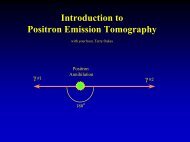
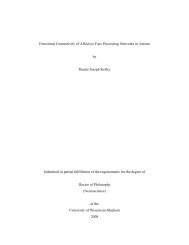
![[F-18]-L-DOPA PET scan shows loss of dopaminergic neurons](https://img.yumpu.com/41721684/1/190x146/f-18-l-dopa-pet-scan-shows-loss-of-dopaminergic-neurons.jpg?quality=85)
